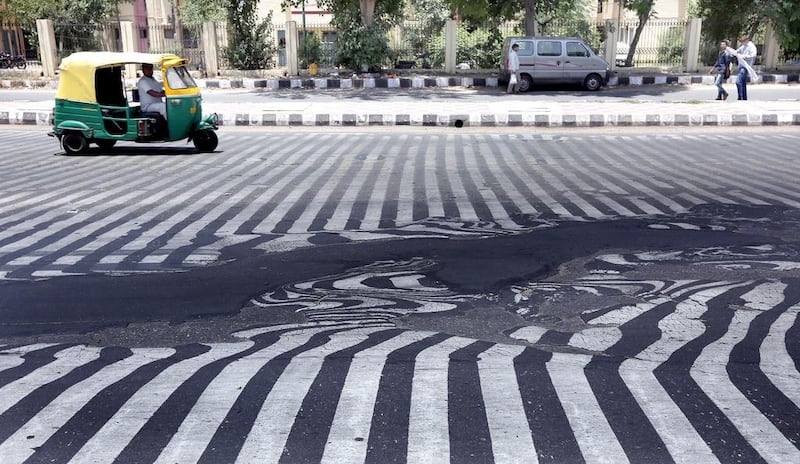NEW DElhi // Forecasters have warned of more fatalities from a heat wave that has already claimed more than 1,000 lives across India, with little prospect of respite from temperatures that have soared to nearly 50°C.
The south-eastern state of Andhra Pradesh has been worst hit, with temperatures nearing 48°C – at least 4 degrees higher than the norm for this time of year, according to meteorologists.
More than 800 people have died in Andhra Pradesh, with another 266 heat-related deaths in neighbouring Telangana state. The government has promised compenstion of 100,000 rupees (Dh5,730) to their families.
“This heat wave is because of a prolonged lack of the sort of weather systems that relieve this kind of heat,” said G P Sharma, the chief meteorologist of Skymet Weather Services, a private weather forecasting firm.
“Usually you have a dust storm or a thunderstorm that brings down the temperatures a little.”
Authorities have advised people to remain indoors as much as possible, to stay hydrated, and to wear hats when outdoors.
In Andhra Pradesh, the government has set up drinking water stations along city streets.
“It’s frightening to even step outdoors,” said V Pradeep, 29, a software engineer in Hyderabad, the state capital. “I had to ride my motorcycle quite some distance yesterday, through bad traffic late in the afternoon. When I parked, I felt light-headed and faint.”
“It was like the heat had sucked all my blood out of my body.”
In Delhi, the national capital, has seen temperatures consistently peaking between 45°C and 46°C. Although this occurs every year, extended spans of such temperatures are unusual. This year it was enough, in one location near Safdarjung Hospital in south Delhi, to melt a patch of freshly laid tarmac, warping the painted lines of the zebra crossing.
The Indian Meteorological Department has predicted that temperatures will remain high in northern India as well as in Andhra Pradesh and Telangana in the south.
On Tuesday, the department issued “red box” alerts for the easter states of Odisha, Andhra Pradesh and Jharkhand, warning of the risks of dehydration, heatstroke and heat-induced fatalities.
Mr Sharma, the meteorologist at Skymet, said the dust storms or thunderstorms that would normally bring down temperature, though not frequent during the summer, should occur once the heat has built up.
“The heat is the trigger, but you still need some moisture, and there isn’t any of that,” he said.
Small storms may still occur over Delhi and southern India over the next four days, Mr Sharma added. “But these don’t bring long-term relief. They will happen in the evening, and the temperature will come down a little for the night, but then the day will begin fresh and hot all over again.”
The annual monsoon rains that bring relief from the summer heat are expected to make landfall over the weekend in the south-western state of Kerala.
However, the first showers in Andhra Pradesh and Telangana will only occur between June 5 and June 10.
And it will be many weeks still before the monsoon creeps up the subcontinent to the northern plains, arriving in Delhi in late June or early July.
Even when the monsoon hits, the first few days of its arrival will be closely watched to determine the fate of agriculture in the season ahead.
Nearly 55 per cent of India’s farmland is irrigated by the annual rains, so a deficient monsoon can translate into low yields for crops such as soya, rice, sugar cane and cotton.
A normal monsoon is defined as the average in annual rainfall for the 50-year period from 1951 to 2000. This is calculated to be about 89 centimetres of rain during the June-September season.
Skymet termed 2014 a year of mild drought, because the monsoon months registered a 12 per cent deficit in rainfall. In some regions such as Haryana, Punjab and western Uttar Pradesh, the deficit was more than 50 per cent.
This year, Mr Sharma is predicting “a normal overall monsoon for the season, with the monsoon breaking over Kerala around May 30”.
“It has been raining there for more than a week already, and these pre-monsoon showers have been strong,” he said.
Although the monsoon rainfall could average out to “normal” over the course of the season and in its distribution across the country, there are likely to be irregularities and deficiencies in various parts of India.
For instance, although the monsoon is set to arrive on time in Kerala, the initial showers next week will not be heavy, Mr Sharma said.
Subsequently, the monsoon’s progress up along the spine of India may be erratic, delaying in one place or hurrying over another place.
“I’ll be watching the monsoon keenly,” said Anupam Sharma, an English teacher in Delhi. “In this kind of weather, we’re all dreaming of the rain.”
ssubramanian@thenational.ae





